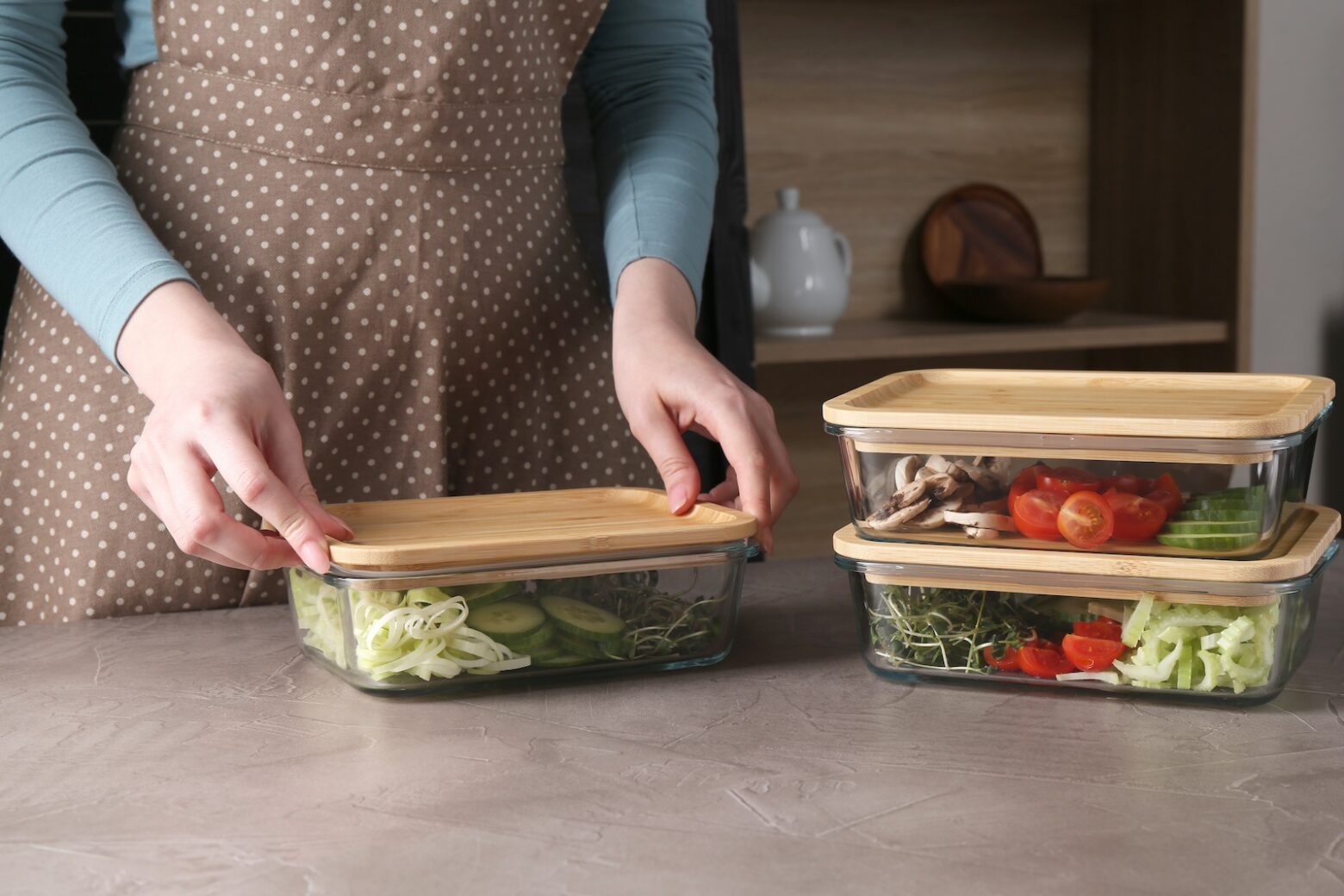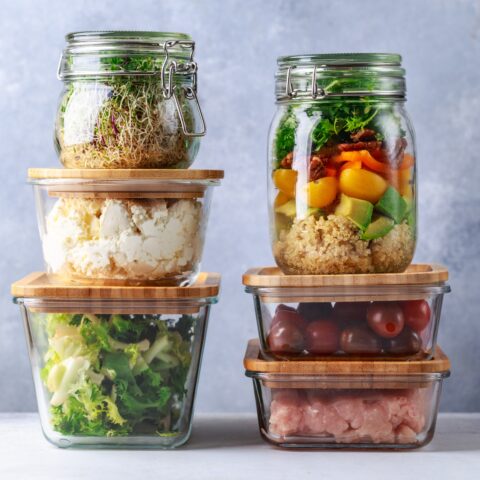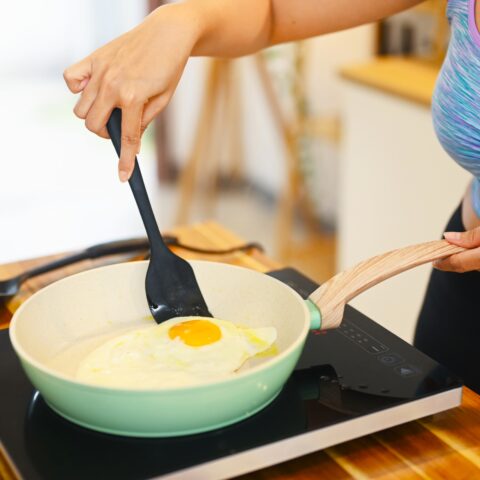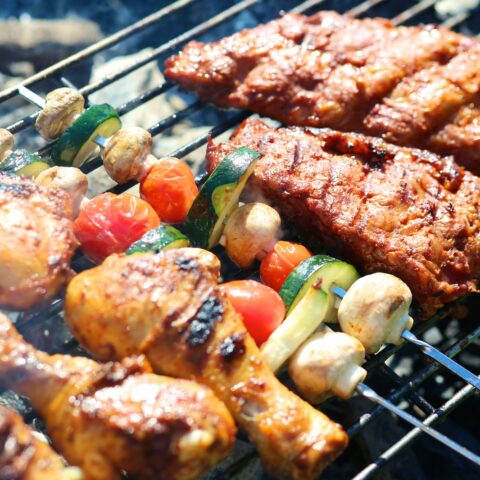Food Storage 101: Safe Food Storage Containers and Best Practices

Most of those following The Paleo Diet® know it’s best to avoid plastics when storing food. But if we’re not using plastic food storage containers or zip-close bags, what are the alternatives besides glass? Here’s a guide to the best food-safe containers and which materials to avoid.
Which Food Storage Materials to Avoid
Some of the most common food storage containers are full of toxic ingredients. Here are some of the worst food storage materials for your health and why:
- Plastic: BPA-free plastics are safer than traditional plastics but can still have other chemicals that may leach into food. This is more likely to occur when exposed to heat or fatty foods. Plastics have also been found to interfere with hormones. [1]
- Per- and polyfluoroalkyl substances (PFAS): There are over 9,000 versions of these “forever chemicals” in circulation. When they accumulate in the body, they can contribute to chronic health issues. [2,3]
- Aluminum: When used to store acidic foods, aluminum ions can leach into the food. Aluminum has been linked to neurodegeneration and other forms of toxicity. [4]
The Best Food-Safe Containers
Modern living requires stocking up on certain ingredients and using refrigerators and freezers. A busy lifestyle often also requires meal prepping for the work week ahead. Here are some safe food storage containers to use instead of plastic.
Glass
Glass is non-reactive to acids and won’t leach chemicals or metals into food. It also doesn’t absorb odors or flavors the way plastic food storage containers do. However, if you do find persistent smells on your glass containers (such as after making pickles), you can let them sit in baking soda or sunlight to deodorize.
Finally, because glass is recyclable, it aligns with The Paleo Diet’s emphasis on sustainable living.
Stainless Steel
High-quality stainless steel is generally considered very safe, as it’s non-reactive and doesn’t leach harmful substances into food. It’s a great choice for those who want to avoid synthetic materials.
Ceramic
Ceramic is a natural clay that has been baked at high temperatures in a kiln. It’s also non-reactive and holds heat well. Look for 100% ceramic when purchasing—this version is reliably free of metals like lead and cadmium. [5]
Bamboo or Wood
Wooden food storage containers are sustainable, natural materials that don’t contain harmful chemicals—but be aware that some wood products may contain glues that hold the item together.
Bamboo and wood are lightweight compared to several other food-safe containers and fairly durable. You can extend the life of your wooden containers by applying a food-grade mineral oil, similar to the care for wooden cutting boards.
Silicone
Silicone is a polymer made from silicon (a natural element found in sand and rock), oxygen, carbon, and hydrogen. High-quality silicone is non-toxic, BPA-free, and absent of other harmful chemicals that may linger in plastic. It’s also flexible, durable, and can provide an airtight seal. [6]
Beeswax Wrap
For a natural alternative to plastic wrap, try beeswax wrap. It’s made by infusing a piece of cotton fabric with beeswax, sometimes along with other ingredients like jojoba oil or tree resin.
The natural heat from your hands is enough to mold the wax into folded packets or cover bowls and cut produce. But take care not to use with hot foods and only wash in cold water to preserve the wax.
Which Containers to Use for Different Types of Food
Here’s a short overview of safe food storage containers to use for storing different types of foods:
- Glass: Best for storing fats, liquids, cooked proteins, vegetables, fruits, and leftovers due to their non-reactive nature.
- Stainless Steel: Ideal for raw proteins, vegetables, nuts, seeds, and portable meals since they’re both durable and non-reactive.
- Ceramic: Great for dry goods and Paleo baked goods. They offer a non-reactive surface with added visual appeal.
- Bamboo/Wood: Suitable for short-term storage of dry goods and baked items. They may be natural and eco-friendly, but they’re not airtight.
- Silicone: Handy for snacks and small meals on the go. They’re pliable, durable, and non-toxic.
- Beeswax Wraps: A breathable alternative to plastic wrap that’s ideal for short-term storage of fruits, vegetables, and Paleo baked goods.
Know Your Container Symbols
Understanding the care symbols on storage containers can help determine if they’re safe for the freezer, dishwasher, oven, microwave, and more.
- Snowflake: A snowflake or a snowflake inside a square means the item can be safely stored in the freezer; crossed out means not freezer safe.
- Water Droplets: A series of water droplets or diagonal lines with a plate or glass underneath is dishwasher safe.
- Square with Wavy Lines: An oven icon—or a square with wavy lines inside it—means it can go in the oven without melting, warping, or releasing harmful chemicals; crossed out means not oven safe.
- Three Wavy Lines/Microwave Icon: Three wavy lines or a microwave icon means it’s microwave-safe and won’t melt, warp, or leach chemicals; crossed-out means not microwave safe.
- Hand in a Bowl of Water: A hand in a bowl of water or under a faucet means the item should be washed by hand, not in a dishwasher.
- Crossed-Out Cup with Steam Lines: A cup or container with steam lines above it and a line through it means the item is not safe for hot liquids.
Paying attention to these symbols can ensure you use your containers safely and appropriately, preventing damage and exposure to harmful substances.
Using the Right Food-Safe Containers for Overall Health
For those fully embracing a healthy diet and lifestyle, safe food storage containers made from natural and non-toxic materials like glass, stainless steel, ceramic, bamboo, or food-grade silicone are the best choices. These options align with The Paleo Diet’s focus on natural, whole foods and provide safe, sustainable ways to store meals and ingredients.
References
- Plastics, EDCs & Health: Authoritative Guide [Internet]. www.endocrine.org. Available from: https://www.endocrine.org/topics/edc/plastics-edcs-and-health
- PFAS | NIOSH | CDC [Internet]. www.cdc.gov. 2021. Available from: https://www.cdc.gov/niosh/topics/pfas/default.html
- PFAS-Tox Database [Internet]. pfastoxdatabase.org. Available from: https://pfastoxdatabase.org/
- Bhattacharjee S, Zhao Y, Hill JM, Percy ME, Lukiw WJ. Aluminum and its potential contribution to Alzheimer’s disease (AD). Frontiers in Aging Neuroscience. 2014 Apr 8;6.
- Sheets RW. Acid extraction of lead and cadmium from newly-purchased ceramic and melamine dinnerware. 1999 Aug 1;234(1-3):233–7.
- SiliconeAB. The Ultimate Guide to Identifying Food Grade Silicone [Internet]. 2024 [cited 2024 Aug 15]. Available from: https://www.siliconeab.com/solutions/food-grade-silicone-guide.html
Betsy Schroeder
Betsy does research and writing for a few different websites in the natural health field after taking Masters level courses in Nutrition & Functional Medicine through the University of Western States.
More About The Author




